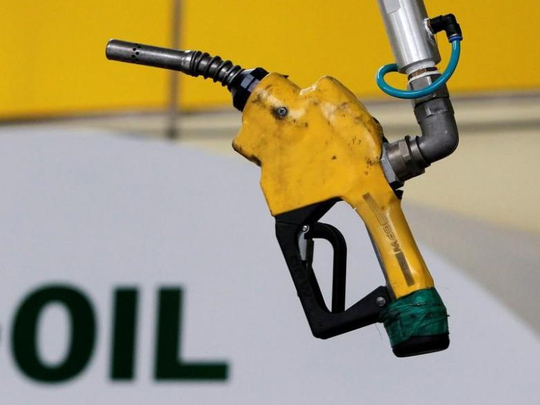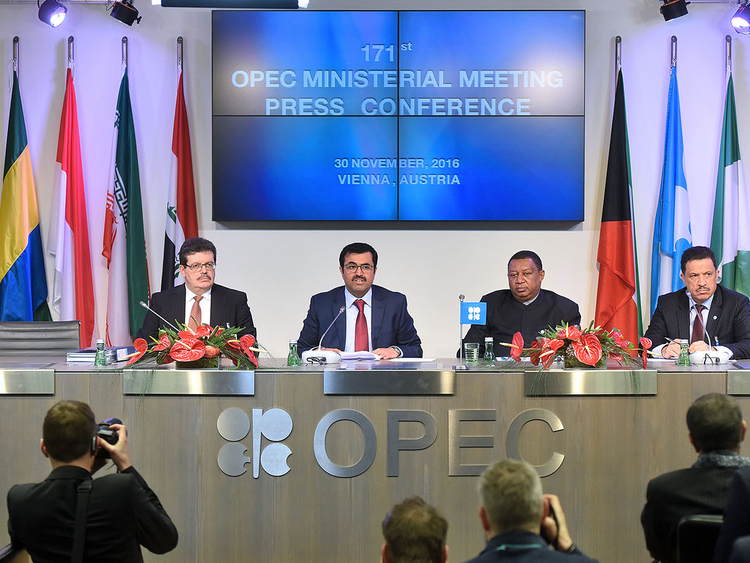
Singapore: Oil prices shot up more than 12 percent, smashing trading volume records, after producer club Opec and Russia cut a deal to reduce output to drain a global supply glut, but analysts warned prices could recede as other producers stand by to fill the gap.
The Organisation of the Petroleum Exporting Countries (Opec) agreed on Wednesday its first oil output reduction since 2008 after de-facto leader Saudi Arabia accepted “a big hit” and dropped a demand that arch-rival Iran also slash output.
The deal also included the group's first coordinated action with non-Opec member Russia in 15 years.
“Opec has agreed to an historic production cut,” analysts at AB Bernstein said.
“The cut of 1.2 million barrels per day (bpd) was at the upper end of expectations (0.7-1.2 million bpd). An additional cut of 0.6 million bpd from non-Opec countries could significantly add to what has been announced by Opec.”
Following the announcements, the price for Brent crude, the international benchmark for oil prices, jumped more than 12 percent from below $50 on Wednesday to $52.31 per barrel at 0441 GMT (8.14am Dubai).
The development also triggered frenzied trading, with Brent futures trading volumes for February and March expiry hitting record volumes.
February Brent traded a record 783,000 lots of 1,000 barrels each on Wednesday, easily beating a previous record of just over 600,000 reached in September. March expiry Brent traded 288,64000 lots of 1,000 barrels each, compared with a previous record of 228,7000 lots done in July 2014.
Energy shares
Energy shares swept higher on Thursday after Opec agreed to cut crude output to clear a glut, while the dollar and bond yields rose sharply on prospects that resulting inflationary pressures will lead to higher interest rates.
The jump in oil prices added to inflation expectations in the United States, which were already high on prospects that president-elect Donald Trump would adopt reflationary policies using a large fiscal stimulus.
As a result US Treasuries resumed their rout, with prices sliding and yields spiking, to send the dollar rallying against its peers.
The yield on 30-year bonds, which are most sensitive to inflation eroding their value, has climbed 9 basis points since late Tuesday, heading back towards a 14-month peak of 3.09 percent marked last week.
Doubts
Yet as markets re-opened in Asia on Thursday, some doubts over the cut began to emerge.
“This is an agreement to cap production levels, not export levels,” British bank Barclays said. “The outcome is consistent with... what Opec production levels were expected to be in 2017 irrespective of the deal reached.”
Meanwhile US bank Morgan Stanley said: “Investor skepticism remains on individual countries' follow-through (on the cut), which is keeping prices below year-to-date highs (of $53.73 per barrel in October) for now.”
On Wednesday, oil prices jumped nearly 10 per cent, boosting energy-linked equities after Opec thrashed out its first output cut since 2008.
The Opec agreement on specific targets to enact a preliminary deal struck in September designed to boost crude prices helped send US oil prices up $4.21 to $49.44 a barrel, Wednesday.
That in turn translated into big upward movements in petroleum stocks globally, with BP rising 3.8 per cent, French peer Total 2.4 per cent and Chevron 2.0 per cent.
Equity markets in Paris, London and Frankfurt all etched up modest gains at closing.
Markets were fixated on Vienna where 14-member Opec agreed to lower its monthly output by 1.2 million barrels per day (bpd) to 32.5 million bpd from January 1.
And Qatar Energy Minister Mohammad Bin Saleh Al Sada said non-member Russia committed to reducing its output by 300,000 bpd, half of a hoped-for 600,000 bpd reduction from outside the organization.
“This was an extremely bullish production decision for oil prices,” said Jason Schenker of Prestige Economics, who likened Opec’s role to that of a central bank.
“In using a play from the playbook of other central banks, Opec, managed to support oil prices through the fall ‘shoulder demand’ period by providing hawkish (and oil-bullish) forward guidance,” Schenker said.
Still, analysts expressed scepticism that Opec would follow through on the ambitious cuts.
“What investors are going to look at now is how long the deal will hold, and whether any of the participants will cheat” on the agreed quotas, said Naeem Aslam, analyst at Think Markets.
Worries about oil have weighed on global equities, which have enjoyed a strong few weeks since US President-elect Donald Trump’s shock election win, on hopes his policies will ramp up economic growth.













